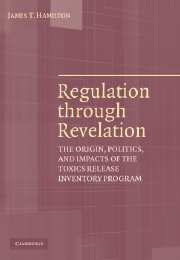 Regulation through Revelation
Regulation through Revelation Book contents
- Frontmatter
- Contents
- Acknowledgments
- Introduction
- 1 Legislating an Incomplete Contract
- 2 Defining Terms: Rulemaking and the Initial TRI Data Release
- 3 Spreading the Word in the Public and Private Sectors
- 4 Politics of Expansion and Contraction
- 5 Life Cycles in the Regulatory Environment
- 6 The Impact(s) of the TRI
- 7 Lessons from and for Regulatory Implementation
- Notes
- Bibliography
- Index
2 - Defining Terms: Rulemaking and the Initial TRI Data Release
Published online by Cambridge University Press: 24 November 2009
- Frontmatter
- Contents
- Acknowledgments
- Introduction
- 1 Legislating an Incomplete Contract
- 2 Defining Terms: Rulemaking and the Initial TRI Data Release
- 3 Spreading the Word in the Public and Private Sectors
- 4 Politics of Expansion and Contraction
- 5 Life Cycles in the Regulatory Environment
- 6 The Impact(s) of the TRI
- 7 Lessons from and for Regulatory Implementation
- Notes
- Bibliography
- Index
Summary
Although books and songs have been written about how a bill becomes a law, fewer tales surround the process of rulemaking. This chapter analyzes the generation of the first set of regulations defining the Toxics Release Inventory from three different perspectives. I first examine the notice and comment rulemaking process that produced the TRI reporting form. Next I explore how the activities of regulators, Congress members, industry officials, environmentalists, and journalists affected the implementation of the reporting program in 1988 and 1989. During the legislative debate over the TRI, many claims were made about whether the information collected would really be new or news. In the final section of the chapter, I conduct a stock market event analysis and examine patterns of newspaper coverage to see the extent that the first release of TRI data in 1989 was news to two sets of observers: investors and journalists.
Defining the Form
On October 17, 1986, when President Reagan signed the Emergency Planning and Community Right-To-Know Act as part of the Superfund reauthorization bill, the resulting law (Public Law 99-499) contained explicit implementation deadlines. The EPA had until June 1, 1987, to issue a reporting form, and firms had until July 1, 1988, to fill out their TRI reports listing their 1987 emissions and deliver the data to the EPA and state governments. The Administrative Procedure Act (APA) contains the road map for how the regulations defining the reporting requirements would be written.
- Type
- Chapter
- Information
- Regulation through RevelationThe Origin, Politics, and Impacts of the Toxics Release Inventory Program, pp. 45 - 74Publisher: Cambridge University PressPrint publication year: 2005


